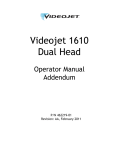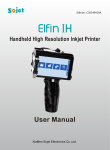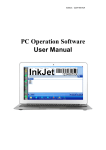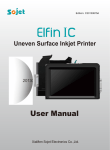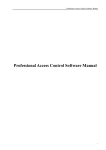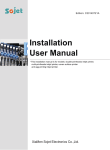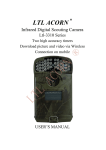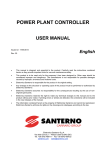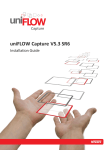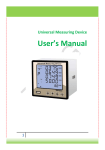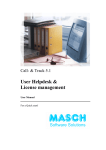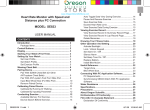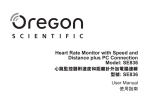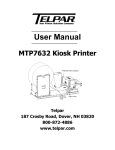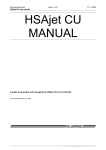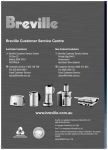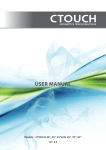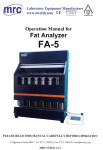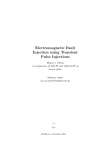Download Edition: C20140510A
Transcript
Edition: C20140510A Uneven Surface Inkjet Printer User Manual XiaMen Sojet Electronics Co.,Ltd. IMPORTANT To ensure the best printing quality, we recommend using only our specified cartridges and the corresponding accessories. Any malfunction or poor printing quality caused by improper use of other kinds of inks or accessories will be not be guarranteed. Safety Precautions There is high voltage inside the machine when it is live. Maintenance or disassembly by unqualified or unauthorized person is strictly prohibited, so as not to cause any accident. Machine must be reliably grounded by connecting the grounding wire for the machine during equipment setup. Unreliable grounding will result in machine failure that the machine cannot work normally. Do not expose ink to direct sunlight or high temperature (35℃ above). The heat of direct sunlight or high temperature will affect ink’s storage life and print quality. If you get ink spill on the eyes or skin during use, please clean your eyes or skin by clean water. Ink leakage inside printer can result in burnout damage to the machine. Switch off the machine and unplug it from power outlet when there’s ink leakage inside printer. Contact qualified service technician for test and repair. Warning Signs Caution: The sign “ ” indicates information for caution of possible damage to hardware of inkjet printer or data loss. Attention: The sign “ ” indicates important notes helpful for your trouble-free operation of the machine. 02 Introduction Content Chapter One: Important Precautions 06 1.1 Important Setup Precautions 06 1.2 Important Operation Precautions 06 Chapter Two: Setup and Installation Instructions 07 2.1 Printheads Adjustment and Installation 07 2.1.2 Printheads Instructions 07 2.1.2 Printheads Adjustment 07 2.1.3 Pole Holder Adjustment for side/down printing 08 2.1.4 Set up printer, deflector, and anti-shock mechanism 08 2.1.5 Bracket Installation 09 Chapter Three: Introduction 10 3.1 Printer 10 3.2 Technical Specifications 12 Chapter Four: How to Use the Printer and the Check Work before/after Use 13 4.1 How to Use the Printer 13 4.2 Check Work before Use 13 4.3 Check Work after Use 13 Chapter Five: Printer Operation Instructions 14 5.1 Main Interface 14 5.2 Printing Management 15 5.2.1 Find/Preview Data 15 5.2.2 Start Printing / Printing Report 15 5.2.3 Printing Delay 15 5.2.4 Print Initial Values 16 5.2.5 Offset Adjustment 16 5.2.6 Stop Printing 16 03 5.3 New/Edit Data 17 5.3.1 New/Edit Data 17 5.3.2 Add Text Object 18 5.3.3 Add Production Date Object 18 5.3.4 Add Expiration Date Object 18 5.3.5 Add Image Logo Object 19 5.3.6 Add Counter Object 19 5.3.7 Add Shift Code Object 19 5.3.8 Add Barcode Object 20 5.3.9 Add dynamical text 21 5.3.10 Add dynamical LOGO 21 5.3.11 Delete Data or Object 21 5.4 System Management 22 5.4.1 System Setting 22 5.4.2 Edit Options 23 5.4.3 Printing Options 24 5.4.4 User Management 26 5.4.5 Special Features 27 5.4.6 Screen Touch Correction 28 5.5 Tools Management 28 5.5.1 Image Management 28 5.5.2 System Upgrade 28 5.5.3 System Backup 29 5.5.4 System Record 29 5.5.5 About Equipment 29 5.5.6 System Reset 30 5.6 Edit Input Method Options 31 5.7 Status Bar 32 Chapter Six: Care and Maintenance 33 6.1 Printer Care and Maintenance 33 6.2 Ink Cartridge Care and Maintenance 33 Chapter Seven: Troubleshooting 34 7.1 Troubleshooting for Ink Cartridge 34 7.2 Troubleshooting for Printer 35 Appendix 1: Terms and Definitions 36 Appendix 2:Offset Adjustment Example 37 04 Please read this manual carefully before you use this equipment. Introduction Thank you for your purchase of high resolution printer. We want you to get helpful information for your work with this equipment; therefore we would like to explain a little bit about how to use this machine by this user manual by the following content: Important precautions for use of the machine Introduction of printer: Parts and components of the machine Setup and Installation Instructions: Instructions for Equipment Setup and Cartridge Installation. How to use the printer and the check work before/after use of the printer: explanations of general operation and startup/shutdown. Operation instructions: explanations on how to new/edit data for printing, and how to adjust printer settings. Care and Maintenance: Care and maintenance for printer and cartridge Troubleshooting: Common failures occurred and solutions Appendix 1 - Terms and Definitions: Definitions for terms used in this document. Please read this user manual carefully before first use of the printer for full understanding and attention of important information so that you will get maximum use from your new equipment. This will also help you have a quick reference to related sections when you have any problems during use. Note 1: If you cannot solve the problem encountered during use, please contact us for assistance. Note 2: The information contained herein is subject to change without notice. The amended information will be updated in user manual by new edition. Note 3: Any machine failure or damage caused by user’s negligence in following this manual will not be covered by the warranty. 05 Chapter One: Important Precautions Welcome to use Printer. In order to protect your personal safety and user rights, ensure correct installation and operation, and full play of the machine, it is important that you read the precautions carefully. 1.1 Important Setup Precautions 1.1.1 Use exclusive power supply for the equipment. Do not share same power supply with other equipment. Besides, Installation of an additional UPS is recommended. 1.1.2 Mount the support in sound and stable place. Do not choose the location that will be easily affected by shock or sway. 1.1.3 Choose well-working conveyor belt for high print quality. 1.1.4 Add deflector to the printer for production line setup in order to prevent any printing object hitting the nozzle plate to cause damage. 1.1.5 Make sure the printer is well grounded. 1.1.6 Maintain the distance between deflector and printing object at 0.5-2.5mm as recommended. 1.1.7 Make sure to insert and remove the ink cartridge by an angle of 15 degree so as not to cause damage to the cartridge. 1.1.8 Make sure the setup environment is tidy and clean. Clean the dust on printer from time to time when dusty environment is unavoidable. 1.2 Important Operation Precautions 1.2.1 Do not poke or impact the touch screen sharply. 1.2.2 Do not cover up the built-in photocell. Otherwise the printer doesn’t print. 1.2.3 Use Non-woven to wipe the nozzle plate when the print is not clear or dots are missing. 1.2.4 Set print delay value for best print result when print position changes (see Section 5.2.3). 1.2.5 Do not insert or remove ink cartridge while the machine is in printing process so as not to cause damage to the cartridge. 1.2.6 Do not use compressed air for cleaning the touch screen. High pressure of the compressed air will damage the touch screen. 1.2.7 Do not use compressed air for direct or indirect cleaning of the ink cartridge. High pressure of the compressed air will damage the nozzle plate. 1.2.8 Read Chapter Seven for troubleshooting when there’s failure occurs. If you cannot solve the problem encountered, contact your local dealer or our after-sale service. Note: Depending on properties, some ink cartridge may require to be removed from printer after use. Turn off the machine and remove the cartridge from printer. Wipe the printhead clean with Nonwoven; cap the printhead with the designed cap for prevention of the nozzles from clogging. (Contact our after-sale service for information of ink properties.) 06 Chapter Two: Installation and Setup Instructions 2.1 Printheads Adjustment and Installation 2.1.1 Printhead Introduction Anti-Shock Mechanism Deflector Earth wire screws 2.1.2 Printheads Adjustment Aviation connector default status Note: for easy operation, installation direction can be adjusted. Remove the 3 screws on the connector, take off the plate, place it into another direction as shown on the picture, then fasten the screws back. Connector Adjustment Finish 07 2.1.3 Pole Holder Adjustment for side/down printing Side Printing Down Printing 2.1.4 Set up printer, deflector, and anti-shock mechanism Note: In normal printing, throw distance is 12.7mm, while need to print on small curve surface, we can change to a 9mm deflector. 2 1 Step 2: Replace with 9mm reflector and tighten the screws. Step 1: Unfasten the 4 pieces M3 screws and take the standard deflector off. 08 2.1.5 Bracket Installation Installation details, please refer to the installation video in the USB disk. Down Printing of Single Printhead Side Printing of Single Printhead Separate Printheads Installation 09 Chapter Three: Introduction 3.1 Printer USB Port Power DB15 port On-Off Switch Port of Port of Printhead 1 Printhead 2 Ethernet port Note:1) DB15 port:can connect with external photocell, encoder, alarm kit or external data source. 2) Ethernet port: can connect with Ethernet cable or external data source. 3) USB port: can connect with USB or external data source. 10 This user manual is a universal version for printer, can be applied to single printhead mode, two printheads combined mode and two printheads separately mode, settings like below: 1. While using single printhead, settings refer to Section 5.4.3, Printing Options→A Nozzle Maintenance →4) Printheads Selection: Printhead 1 or Printhead 2. Note: while using build-in photocell, user can choose which one to use, the one on Printhead 1 or on Printhead 2, settings refer to Section 5.4.3, Printing Options→D Build-in Photocell Setting→ or ; 2. While using double printheads combined, settings refer to Section 5.4.3, Printing Options→A Nozzle Maintenance→Printhead Selection: Double Printheads Combined. Note: 1) While using build-in photocell, user can choose which one to use, the one on Printhead 1 or on Printhead 2, settings refer to Section 5.4.3, Printing Options→D Build-in Photocell Setting→ or ; 3. While using double printheads separately, settings refer to Section 5.4.3, Printing Options→A Nozzle Maintenance→Printheads Selection: Double Printheads Separately. Note: 1) While using build-in photocell, user can choose which one to use, the one on Printhead 1 or on Printhead 2, settings refer to Section 5.4.3, Printing Options→D Build-in Photocell Setting→ or ; 2) While using double printheads separately, Spit function and Purging function can be set separately, steps refer to Section 5.4.3 Printing Options→A Nozzle Maintenance→ and 3) While using double printheads separately, Printing Direction and Channel Switch can be set separately, steps refer to Section 5.4.3 Printing Options→A Printhead Setting or . 11 3.2 Technical Specifications A. Performance Values Item Technical source Dimension Power supply Print heights Specifications HP TIJ 2.5 Thermal Ink Jet technology controller(H*W*D): 210*135*37mm/8.3*5.3*1.46inch Print head(H*W*D): 142*133*55mm/5.6*5.2*2.15inch Including the spring mechanism AC 90V-240V/50-60HZ, 90W (Dedicated AC); 1~12.7mm Print speed 0~60m/min(300DPI) 0~30m/min(600DPI) Resolution 50~600DPI Print application Barcode, alphabetic, numeric, image logos, date/time, expiration date, shift code, counter, lot-box code Connection Ports Note 1) Ethernet: 100Mb/s, Synchronized control of multiple devices via PC; 2) USB2.0: Support U-Disk; 3) DB15: For external devices like photocell, synchronizer or alarm kit connection; 1) 7 inch 800 *480 color LCD touch screen; 2) With touch screen interface operation, easy to use; 3) Printer can work separately without PC software; Interface Ink management Mounting Product Certification Environment requirement 1.Automatically recognizes ink types, and identifies optimum printing parameters for each ink type; 2. Guarantees the using of genuine original HP ink; 3. Automatic measuring system for the usage of ink. Standard side and downside printing assembly, customers can fix it flexibly; CE, FCC. 1. Working environment: -10°C~ +55°C; 10%-85%RH; 2. Storage environment: -25°C~ +80°C; 10%-90%RH. B. Features: Item Languages Font Barcode Date format Device's Database suport PC Software's Database Specifications Chinese, English, Japanese, French, Spanish, Portuguese and Russian. Note German, Default font is Arial; allow users to load fonts they need. UPCA, UPCE, EAN13, EAN8, INT25, CODE39, CODE128, EAN128, PDF417, DATAMATRIX, QR. Variety of date formats available Provide standard port of RS-232, Ethernet, easy to integrate for customers MS Excel, SQL2008 MS Access, SQL2000, SQL 2005, C. Ink Solutions: 1. Support 42ml, 370ml, 350ml cartridges of HP TIJ2.5 technology; 2. Support ink of various colors: black, red, green, yellow and blue; 3. Support porous, semi-porous and non-porous substrates. 12 Chapter Four: How to Use the Printer and the Check Work before/after Use In this Chapter, you will learn how to use the printer, including check work before and after use. Note: After printer starts, firstly set the printheads and build-in photocell, details please refer to Section 5.4.3 4.1 How to Use the Printer Sq # 1 Procedure cartridge Installation 2 Turn on printer 3 Main Interface Printing Management 4 Select data Start printing 5 Printing report 6 Stop printing 7 Switch off Instructions Insert cartridge into the printer stall by an angle of 15 degree, close cartridge clip to secure. (see 2.3 Cartridge Installation) Connect power adapter to printer power input, switch on power, printer enters initialization startup. After initialization startup, “main interface” appears (see Section 5.1). Click to enter “Printing Management” (see Section 5.2). Select a file on data list, click to Start printing. When printing starts, the button change to the icon for stop printing, meanwhile a printing report appears. Click to stop printing, printing report exits, and the button returns to “Start printing” status. Exit printing, and switch off power. 4.2 Check Work before Use Sq # 1 2 3 4 5 Item Printer support Printer position cartridge Power input Printer status Check Work Is the support securely mounted? Is the printer orientation correct? Is the nozzle plate parallel to printing object? Is the throw distance controlled within 0.5-2.5mm? Is the cartridge wiped clean? Has the cartridge been installed to printer? Is the printer input voltage normal? Check status bar, is the equipment status normal? 4.3 Check Work after Use Sq # 1 2 Item Printer Power Status cartridge Check Work Is the printer power switched off? Is the cartridge removed from printer and wiped clean and printhead capped? 13 Chapter Five: Printer Operation Instructions This chapter explains how to operate printer interface, including Printing Management, Data Management, System Management, Tools Management, and Status Bar. 5.1 Main Interface Switch on power, printer starts initialization startup. After initialization startup, “main interface” appears . Setting Management Printing Management Status bar Message Management Tools Management To find and preview data, start/stop printing, set printing delay value, and set Printing Management printing initial values (see Section 5.2). Message To Find/Preview, File-new, Edit, Delete data (see Section 5.3). Managemen To manage system setting, editing options, printing options, user authority, and Management screen correction setting (see Section 5.4). Setting Tools To manage image logo, system upgrade, system backup, system record, Management equipment default restoring, system resetting (see Section 5.5). Status bar Display information of ink, equipment, USB, encoder, external photocell, and Ethernet status (see Section 5.7). 14 5.2 Printing Management Click on main interface to enter printing management. Preview interface Scroll bar Start printing Printing delay Initial values for printing zoom Page up File name Page Down Return Search Keywords entering bar 5.2.1 Find/Preview Data A. Find data B. Preview data Find by Pageup/Pagedown/keywords. Preview data by locating or selecting a file of data to display on preview interface; ddata located/selected will be displayed in sequence on preview interface. Note: Drag the scroll bar horizontally to view the data when it exceeds the screen horizontally. 5.2.2 Start Printing / Printing Report Click button to start printing. When printing starts, a printing report appears. Printing report: It is the timely record of printing in process, including data file name in process, print output quantity, counter value, shift code, system time. The printing report exits when printing stops. Stop printing Printing report 5.2.3 Printing Delay Click , printing delay setting interface appears . See Appendix 1: Terms and Definitions 1 for more information. Note: While the printheads setting is seperately as , the print delay value need to be set independently. A. Printing delay default value: 30mm; B. Printing delay value range: 0.0-999.9mm; C. It is allowed to set printing delay value during printing process: the newly set value becomes valid for immediately next printing. D. Printing delay value for each message are independent from one another, the delay setting for current data file will not affect another data file. 15 5.2.4 Print Initial Values Click , the interface of initial values setting and repeated index value checking appears. 36 Base System: select the regulation, when setting is , input is 0-Z (not including I & O); Default setting is decimal from 0-9. 36 Base Counter synchronizing See Appendix 1: Terms and Definitions 2 for more information. Counter Synchronizing: when multi counter included in the same file, click , then all counters’ current value will be synchronized to counter 1’s current value. After confirmed, a dialog box will display the counters’ setting, user can set the counter’s begin/end/step/repeat number and the binary regulation. 5.2.5 Stop Printing Click to stop printing and exit printing report, return to Start Printing status (see Figure 2). Note: Printer automatically stops printing when there is case as power-off, out of ink, alarming etc. 16 5.3 New/Edit Data Click on main interface to enter data management interface . New Modify Import Copy Delete 5.3.1 New/Edit Data Click or on Data Image Logo Management interface to enter data Expiration date edit interface. A. New: text, counter, shift, production date, expiration date, image logo, barcode. B. Edit: data in printing process cannot be edited. C. File name: maximum 15 characters, empty file name or repeated file name not allowed. Counter Production date Text Shift code Add objects Delete objects File name barcode Dynamical LOGO Dynamical text Click to save data when finish editing, a check box appears to ask “Are you sure you want to save the message? Cancel, Yes, No” If you click “ ”, the machine will remain on editing interface. Note: “MSG001” is default data in system, not editable and not erasable. The system allows maximum 500 files of data (including default MSG001). The system does not save empty data. 17 5.3.2 Add Text Object Click to add text object. Horizontal scale Height Click to enter text editing interface: Text A. Font: default font Arial, support 2 fonts at Edit same time, Arial and one alternative font. B. 16-418( adjust freely within the scope of Vertical 1-25.4mm); scale down and C. Text horizontal scale: 1-300%; location up D. Text content cannot exceed 25 characters. Click to enter text adjustment interface. E. Coordinate location: adjustable range for X axis 0-3000mm; for Y axis, 0-25.4mm. F. Text orientation: 0°, 90°, 180°, 270°. Four orientations adjustable. G. Font effects: bold, italy, underline, strikeout, four effects adjustable. Vertical scale up and location down Coordinate position Orientation Font effect Note: Please refer to this Section (Section 5.3.2) regarding how to add objects as “production date”, “expiration date”, ”image Logo”, ”counter”, ”shift code”,"dynamical text""dynamical logo", but the content of “production date”, “expirationdate”, ”counter”, ”shift code”"dynamical text""dynamical logo" cannot be revised or adjusted directly when you add, and the font, height, content and font effect of “image Logo”"dynamical logo" cannot be revised directly. There is no option of horizontalscale “ ” for “logo” “barcode”,"dynamical logo". 5.3.3 Add Production Date Click date”. to add object “production Click to enter date format setting, choose a format by arrow up and down, Gregorian and Hijri available. Date format Calendar Type Adjust 5.3.4 Add Expiration Date Click date. to add object of expiration Click to enter date format setting and days to expire (scope: 0~9999), Gregorian and Hijri available. Days to expire Calendar Type 18 5.3.5 Add Image Logo Click to add object image Logo. Select a logo on file list by page up and down . Image file list Note: When there is no image file found, a message box appears to prompt image import . See Section 5.5.1 Image Management for image logo import. 5.3.6 Add Counter Click to add object counter. Click to for option of common counter, box number, lot number. A. Click for common counter setting: minimum value, maximum value, stepping value, repetition number. B. Click and for option of box number and lot number setting: minimum value, maximum value, stepping value for box number and lot number . Note: There is no repetition number for box number or lot number. Common counter Box No. Lot No. Stepping value 10D/36 Ary Repetition number Minimum value Maximum value 5.3.7 Add Shift Code Click to add object “shift code”. Click to enter setting. Shift code: shift name and time for setting. Shift name: maximum five characters. Shift time: four different times for setting. Shift code varies according to different time periods. 19 5.3.8 Add Barcode Click to add object “barcode”. A. Click to enter barcode edit: Barcode type, horizontal scale level, barcode height, barcode text . Barcode height Barcode type Horizontal scale level Barcode text B. Click to enter barcode adjustment: coordinate location, text orientation, text display/hide, text height, error correction level, white space level . Note: Setting options may differ depending on different barcode types. Text display Text height : Text display; : Text hide; ~ ~ : error correction level; : white space level. Error correction level White space level C. Click to enter barcode setting: barcode can include data source of production date, expiration date, counter and shift code,dynamical text. When an object is inserted to a barcode, its icon will be lightened, for example, when a barcode contains a production date, the icon of production date will be lightened like . 20 5.3.9 Add dynamical text Click to add dynamical text. A.Click to the interface of dynamical text setting with the way of dynamical transmission path or communication protocol . 5.3.10 Add dynamical LOGO Click to add dynamical LOGO.See the picture beside. Note: pls refer to 5.3.9 of adding dynamical text, set the data transmission path communication protocol. 5.3.11 Delete Object or Delete/Import/copy Data Select an object on data editing interface, click to delete the object, a dialog box appears to prompt if you are sure that you want to delete. Select a file on the list on data management interface, click to delete the file, a dialog box appears to prompt if you sure that you want to delete . Note: data in printing process cannot be deleted. Click in File Management interface, it will import all files saved in U disk under defined route. User will be prompted if same name already existed. Before import, insert the U disk firstly. Select a file and click in File Management interface, the same message will be copied and saved as the same name with “C1” suffix, for example: MSG002’s copy will be named as MSG002C1. 21 5.4 System Management Click to enter system management. Special Features User management Printing options Editing options System setting Screen correction 5.4.1 System Setting Click on system management interface to enter system setting . System Language System time Screen saver time unit Calendar Type Daylight saving time A. System language B. System time C. Screen saver time Standard language in delivery country as default language. Manufacture time as default time, can be set by user. see Appendix 1: Terms and Definition 3. 1) System default 5 minutes, 4 options for changeover: 5minutes, 3 minutes, 1minute, OFF. 2) If screen saver is optioned OFF, screen enters standby status if inactive for 1hour. 3) Screen becomes active when there’s alarm or error. D. unit Switch between mm and inch.language in delivery country as default language. E. Daylight saving time Three modes for setting: OFF, European summer time, US summer time. F. Calendar Type two modes available: Gregorian and Hijri.Default setting is Gregorian; System time will be changed according to the calendar setting. 22 5.4.2 Edit Options Click on system management interface to enter edit options setting interface. A. Click to enter production date and expiration date format setting. Note: six common date formats default, forty-four more formats addable for user. The six default date formats not editable and cannot be deleted. Date format New format Edit format Delete format Click or in date format setting interface, new or edit date format, date format edit interface appears. B. Click setting. to enter special time Customer year see Appendix 1: Terms and Definitions 4, 5. Date transition time setting Pre-zero in date/time Special time setting (Figure 30) 1) Customer Year setting: round number within 0~9999; 2) Date transition time setting: system default normal zero o’clock as date transition time to next date, users can set different time as date transition time. 3) Pre-zero in date/time: four options: OFF, empty preposition, empty postposition, centered without zero. (e.g. 2012/05/09, 2012/_5/_2, 2012/5_/2_, 2012/5/2). C. Click setting . to enter counter Production counter Counter pre-zero Counter alarm Counter reset Counter setting 1) Production counter: setting extent: 0~99999999. 2) Pre-zeros: four options: OFF, empty preposition, empty postposition, centered without zero (e.g. 0001, ___1, 1___, 1). 3) Counter alarm: ON or OFF option. When counter alarm is turned ON, the machine will stop printing, sound alarm and prompt message that print number reaches maximum value. 4) Counter reset: ON or OFF option. All counters will start from initial values if the counter reset is turned ON. The printing value will continue with the last one if the counter reset is turned OFF. 23 5.4.3 Printing Options Click on system management interface to enter printing option setting. Click , to enter nozzle maintenance setting. Nozzle Maintenance Selection Printhead Pre-purge level Pre-purge Pre-purge Mode Note: 1) Pre-purge Mode: 2 modes: Clean Printhead both right & left nozzles; the working nozzles only. 2) Pre-purge: four shifts: OFF, low, medium, high. see the following figures: --Off; --Low; --Medium; --High While the printheads work separately, can set single printhead by printhead 1 or printhead 2. 3) Clean Printhead: Spray 300 rows of ink dots at one time. This function is invalid while printer is printing While the printheads work separately, can clean single printhead by printhead 1 or printhead 2. 4)Printhead Selection:4 choices: printhead1、printhead 2、double printheads combined、double printheads separately. --Printhead 1; -- Printhead 2; -- Double printheads separately. see Appendix 1: Terms and Definitions 6, 7. B. Click Setting. to enter printhead Printhead Setting Printhead Setting Channel switch Printing Recovery Note: 1) printing direction: system default from left to right. Four directions optional: left-to-right, right-to-left, mirror sides of left-to-right and right-to-left, see figures as follows: -- Left-to-right; -- Mirror side of left-to-right; -- Right-to-left; -- Mirror side of ight-to-left While the printheads work separately, can do single setting for printhead 1 or 2) channel switch: Left channel, Right channel, Dual channel, see the figures as follows: -- Left channel; -- Right channel; -- Dual printhead 2. 24 While the printheads work separately, can do single setting for printhead 1 or printhead 2. see Appendix 1: Terms and Definitions 8. Click ,to enter production line Setting. Line speed: system default 30m/min; Adjustable scope 1~150m/min; DPI: system default 300DPI; Adjustable scope 50~600DPI. Click Line Setting Line speed DPI Line speed setting on line speed setting interface to run speed test. Speed Line speed test: input test object length 0~3000mm,click Test object length to enter speed test interface, then start production line, put test object onto production line, the photocell will be sensing the object, and the machine will calculate line speed automatically. Click Run speed test to save current Save Cancle speed test result. Click current speed test value will not be saved. If test repeated, system will take average value of multiple results. Click stop speed test, and click or to to save or give up test result. Stop speed test Note: if an encoder is connected, system can detect it automatically, and switch line speed interface to encoder DPI setting interface, in this case user cannot set the line speed. D.Click , enter the build-in photocell setting. Build-in photocell switch Build-in photocell setting Note: 1) Build-in photocell setting: can choose to use the one on Note: setting can not be adjusted while printing. Printhead 1 or Printhead 2. 25 5.4.4 User Management Click on system management interface to enter user management (see Figure 37). A. User permission management switch: system default OFF. A login dialogue box requests user name and password for access to operation of the User name printer when machine power is switched on. User B. User name: different names for different access permission permission. Administrator is of best authority, with switch access to all settings including password Password modification. Engineer is with access to data management and printing management; and Password operator is with access to printing management confirmation only. C. Password and password confirmation: administrator creates user name and set password. Maximum 15 characters for password. Default administrator password “888888”. Note: Please contact local dealer or our company for printer unlocking when you forget administrator password. 26 5.4.5 Special Features Click on system management interface to enter “Special Features” setting. A. Click to enter “Continuous printing” setting. See Appendix 1: Terms and Definitions 9 for more information. 1) Continuous output times: system default 0 (OFF). Adjustable scope 0~9999. Note: 0 is equal to OFF; 9999 equal to infinite. 2) Output interval: system default OFF, adjustable scope 0~999mm. B. Click Features”. Continuous printing Continuous output times Output interval to enable “Special Enable Special Features Note: Enable special features by registration code. Registration code C. Click to do Alarm settings. User can choose Alarm Light or Production Line Control. Alarm Light: operation please refer to above picture. Production Line Control: Printing; Stop Alarm Light Device Abnormal; Ink Use-up; Ink Alarm; These options can be multi-selected. When the above situation happen, printer will transfer the error signal to the production line via DB15 ports, user can set the production line reaction like stop or etc. D. Press interface Alarm P.L control Stop printing Ink Use-up Device Abnormal Ink Alarm , entering UV setting Note: Can set the UV delay distance; Adjustable scope 0-3000mm. UV LED Setting UV Delay Distance 27 5.4.6 Screen Touch Correction Click on system management interface to enter screen touch correction. Note: Please correct screen touch when there’s inaccurate touch phenomenon. Icon “+” appears on different location on screen guides you the screen correction. The interface exits after screen touch correction finished, and a message appears to prompt screen touch correction success or failure for your attention. 5.5 Tools Management Click on main interface to enter tools management interface. About printer System record Backup management Upgrade management Image Logo System reset 5.5.1 Image Management Click to enter image Logo management interface. Image import: import image from USB or Ethernet. Image format: Solid color BMP; Image height: 0-300 pixel point. Image length:0-10000 pixel point. File list of Image Logo Import image Delete image Note: 1) System prompts and cuts the excess part if the imported image exceeds borders. 2) Image import cannot be executed when pixel points exceed 100. 3) Image Logo document route: USB Disk/InkJet/Logo. 5.5.2 System Upgrade Click to enter upgrade management interface. Users can upgrade the software, add or change languages and fonts by USB. Upgrade document list Software upgrade Language upgrade Font upgrade Execute upgrade A. Software upgrade System automatically searches for software upgrade documents in designated folder and displays the upgrade documents by list. User can select anyone in the list for upgrade. Document route: USB Disk/InkJet/Upgrade/Application. B. Language upgrade System is loaded with multiple languages upon delivery. User can add one more language if needed. Document route: USB Disk/InkJet/Upgrade/Language. C. Font upgrade System supports two fonts; user can add another font besides the default Arial. Document route: USB Disk/InkJet/Upgrade/Font. Note: Software upgrade documents, language documents, font documents can only be identified when they are packed by the conversion tools provided by our company. The language documents, font documents are not replaceable and cannot be deleted. 28 5.5.3 System Backup Click to enter backup management. Import backup Click , enter the backup interface; Backup A. Import backup: Import all the documents except system record to printer by USB. B. Export backup: Export the documents including input data, machine settings, images, system record, excluding software, fonts, languages, status, and user management. Click , enter “backup import” interface; A. Import: import files, images or settings from USB disk’s default route to printer. B. Export: export files, images or settings from printer to USB disk. Note: While importing, existing information will not be covered, if same name is found, will indicate. While exporting, can multiple choose on files, images or settings. Execute import Execute export Export backup Import backup Execute import Execute export Imp./Exp Export backup Message Logo Settings Note: Please check USB connection status and disk space is normal when execute backup import and export. Backup document route: USB Disk/InkJet/Backup. 5.5.4 System Record Click to enter system record viewing interface. All operation activities including operator, operation and operation time will be shown. 1) The printing activities: printing start and stop, initial values. The printing activities: initial values setting diary. System record information includes: 3) All operation activities in system management (including touch screen correction). 4) Image import and delete activities, system upgrade, backup, and reset activities. Note: System record does not include querying and viewing activities. 5.5.5 About Equipment Click to enter equipment information viewing interface. Information displays current hardware version, software version, machine serial number, dealer code, company Logo, company name and website. 29 5.5.6 System Reset Click on tools management interface to enter system reset management . Click to execute system reset. You need to enter administrator password for permission to reset execution. Note: System reset is to restore all defaults. 1) Restore all the settings to defaults, clear all data and images. 2) Maintain software version in current version; restore language and font to default. After system reset, system parameters are as follows: Item # 1 Item Parameter Language English 2 System time Manufacture time 3 Screen saver time 5 minutes 4 Unit Metric/mm 5 Daylight saving time OFF 6 Customer year OFF 7 Date transition time setting OFF 8 Pre-zero in date/time OFF 9 Pre-zero in counter OFF 10 Counter alarm OFF 11 Counter reset OFF 12 Pre-purge OFF 13 Clean printhead Standby 14 Printing direction Left-to-right 15 Channel switch Left channel 16 Print Recovery OFF 17 Line speed 30m/min 18 DPI 300DPI 19 User permission management OFF 20 Continuous output times 0 OFF 21 Data management Only system default data Msg001 22 Printing delay 30mm 23 Printing initial value Counter initial value and data source current value. 30 5.6 Edit Input Method Options A keypad appears when user clicks the editing bar. Keypad of Uppercase, lowercase, numeric, or common symbols for changeover. A. Uppercase: uppercase keypad is pre-set keypad to appear (see Figure 50). B. Lowercase: click to change between uppercase and lowercase. C. Numeric and common symbols: Click to change between numeric or common symbols input. D. More symbols: click on numeric/common symbols keypad for more symbols. Input changeover key Numeric/common symbols and alphabetic input changeover key. Remove key (clear all input) Delete (delete one character) Hide keypad 31 5.7 Status Bar Ink information includes dynamic and static information. Static information includes cartridge serial number, client code, cartridge type. Dynamic information: 1) Ink volume, prospect print output for current data. 2) Ink used percentage, remainning prospect print output for current data. Ink information Ink status icons include: 1) Normal ( ): Normal ink status. 2) warning ( ): ink amount lower than 10%; 3) Error ( Equipment status USB information ): wrong cartridge, cartridge not installed, or ink used up. Hardware and software status in printer. (e.g. Printing not started ) Automatically displays by icon for equipment normally connected to USB port. Support three devices: USB disk, mouse, and keyboard. Status: not connected (gray), normal connection (green), warning (yellow). Normally connected equipment will be displayed by icon mouse, or USB disk, keyboard. When encoder is Encoder information Photocell information Ethernet information Displays encoder or photocell connection status as unconnected (gray) and normally connected (green). connected, click encoder signal test interface appears. , When photocell is connected, click photocell signal test interface appears. , The printer connection to computer is realized by Ethernet port, therefore realizes equipment operation and upgrade transmission on PC end. Information includes display IP, mask code, MAC, gateway. Status includes: Unconnected (gray); Normally connected (green, interaction with PC software normal); Warning (yellow, interaction with PC software wrong, connection failure, software on PC not activated, computer not switched on etc.). UV status When UV LED is connected with printer, UV status will displayed on the screen. UV status including: type, serier number, software version, hardware version, run time. 32 Chapter Six: Care and Maintenance Printer is a precision machine. To keep your machine work properly and bring facilitation to your production; to keep your machine in good condition and extend equipment life, it is important to carry out proper care and maintenance on machine from time to time. 6.1 Printer Care and Maintenance 6.1.1 Make sure power cord, power adapter cord, grounding wire is in good condition. Make sure the contact of each cord or wire is reliable. 6.1.2 Make sure the screw for grounding wire is secured and the grounding is reliable. 6.1.3 Make sure the equipment is not displaced. Make sure the nozzle plate is parallel to printing object, and printing distance is controlled within 0.5-2.5mm. (Please use the designed tools provided by our company to secure the mounting support). 6.1.4 Clean ink cartridge: wipe nozzle plate with Non-woven to keep nozzles clean and unclogged. (Please refer to ink cartridge care and maintenance for instructions). 6.1.5 Keep touch screen clean. Do not hit touch screen sharply. 6.1.6 Keep machine surface and ports clean. 6.1.7 Check status bar, make sure equipment icon is normal and there’s no alarming status on status bar. (In case of alarm status, check troubleshooting for solution) 6.1.8 When machine is turned off, make sure to remove the cartridge from printer, clean the nozzle plate and cap the printhead, and place the cartridge in safe environment. (Please refer to cartridge care and maintenance for instructions). 6.2 Ink Cartridge Care and Maintenance Maintain correct methods for use and storage of the cartridge will keep the cartridge work with best print quality and extend cartridge life. Please always follow instructions in Ink Cartridge Care and Maintenance. The warranty will not cover damage or failure caused by negligence in following our care and maintenance instructions. 6.2.1 Ink volatilizes slowly if the cartridge is decapped. Keep new and undecapped cartridge in its original package. Decap new cartridge only when it is to be used. 6.2.2 Try to use up ink as soon as possible once the cartridge is decapped to prevent blockage because ink become dry on nozzle plate very soon. Note: Due to property difference, different inks have different dry time and care and maintenance methods. Contact our after-sale service for more information. 6.2.3 If ink in cartridge is not used up at a time after decapped, remove the cartridge from printer and cap the printhead and store it in airtight container provided by our company. (Storage temperature is room temperature). Note: Do not use adhesive tape to seal the printhead, and do not store cartridge in soft plastic bag. 6.2.4 Nozzle plate is delicate. Do not touch or clean nozzle plate with anything sharp or rough so as not to scratch nozzle plate. 6.2.5 Use the Non-woven provided by our company to wipe and clean nozzle plate. Note: Wipe nozzle plate with the printhead facing down. Move the printhead in the direction of nozzle channel. Move the printhead in the direction across nozzle channel will damage the nozzles. 6.2.6 Do not shake ink cartridge or expose it to vibration. Shake or vibration will get air run into cartridge and affect print quality. To ensure best print quality, contact our company’s after-sale service for information of instructions for different inks. 33 Chapter Seven: Troubleshooting Note 1: The table below lists the most commonly seen problems and the solutions to each. If there’s any other problem, contact your local dealer or our after-sale service for assistance. Note 2: The table below is for reference only because causes for each problem may differ depending on individual situation such as setup environment, operation demand. 7.1 Troubleshooting for Ink Cartridge Sr.# 1 Problem Problem 1. Nozzle blockage The print has or damage. broken line or white line. 2. Cartridge not in good contact with printer. Solutions A. See Section 6.2 Ink Cartridge Care and Maintenance, wipe and clean nozzle plate with Non-woven; B. See Section 5.4.3, purge the nozzles by the option “Clean Printhead”. 2 A. Check status bar if there’s alarm of low ink. B. Send back to our company for test. 3 The print is totally blank. See Section 5.7 to check ink status: is ink used up? 4 Unable to identify ink cartridge. If the problem is still unsolved: Check if there’s any spring-loaded connectors depressed in Driver board; Check if there’s contamination on cartridge contact plate. Remove the cartridge and re-insert. The print is complete at Ink starvation or air first, and then bubbles blocking becomes nozzles. incomplete Ink used up or total nozzle blockage. Comments 1. Connectivity problem on printer (defect or damage) Remove cartridge and re-insert. 2. Cartridge dealer code mistake. Remove cartridge and re-insert. If problem is unsolved: Check if there’s any spring-loaded connectors depressed in driver board. Check if there’s contamination on cartridge. Check if there’s contamination on ISM card. Check if there’s any connector depressed on ISM card board. 34 7.2 Troubleshooting for Printer Sr.# Problem Cause 1.No power input; 1 Printer cannot be switched on Solutions Comment A. Make sure AC power input on adapter is correct, DC output on adapter is well connected with printer. B. Check if power adapter light is normal. Replace a new adapter if light is dead, dim or blinking. 2. Printer switch not turned on. Make sure the printer power switch is turned ON. 3. Equipment damage. Contact local dealer or after-sale service. Pls check firstly if the 1. Printing not started. current status is in printing. 2. No data for printing. Select a file and click “Start printing” button. 3. Printing delay value Check if the printing delay value is normal. too big. 2 Printer does not print 4. Cartridge not installed. 5. Cartridge installed but used up or damaged. Install a cartridge. Check cartridge status according to Section 5.7, If ink used up, or cartridge is ink used up or cartridge dealer code wrong, replace a new cartridge. dealer code wrong? Cover up the photocell to check according to 5.2.2 6. Photocell not works. to see if there’s variation in print output quantity in printing report. 7. Encoder is connected but damaged. Check if the encoder and its connection wire are in good condition; check if the production line is running well. When the external equipment is photocell, click for photocell signal test interface, test if photocell works. When the external equipment is encoder, click for encoder signal test interface, move encoder to check if the encoder works. 35 Appendix 1: Terms and Definitions Sr.# Term Definition Comment It is the distance from the point when E.g. Printing delay value is 30mm, photocell senses the printing object printer starts printing at 30mm point after to the point when printing starts. the photocell senses the printing object. User can adjust the value to alter the print position on printing object. 1 Printing delay 2 Printing initial value It is beginning value in printing process for print data. E.g. Set the initial value as 9, the counter counting starts from 9 for first print. 3 Screen saver time It is a power saving function, the screen will automatically turn off and enter standby mode when the screen is inactive for a time period as set. E.g. Set the screen saver time as one minute. The screen will automatically turn off and enter standby mode if the screen becomes inactive for one minute. It is the special year on customer demand. Customer can change the year in date format by any round number within scope. E.g. The system date is 2012/07/31. Supposed the date by customer is 2010/07/31, customer can set the year in date as 2010. Then the date shown on the print will be 2010/07/31. 4 5 Customer year Date transition time setting When system time reaches certain point, the printout date and time will be that of the next date. For example: Current date is 07.10, set the date transition time to be 07:59,then the time of last printing out before that is recorded as 09/07 07:59, after that is 10/07,8:00. If the date transition time is 12:01,then the time of last printing out before that is recorded as 10/07 12:00,after that is 11/07. Ink becomes dry on nozzle plate during use. The dried ink will make the print not clear for half of first character. To prevent this phenomenon, user can turn this function ON. When Pre-purge function is turned ON, printer will spray a little ink at optioned level during idle period in printing process to keep nozzle plate warm and moist so as to eliminate dried ink phenomenon. Customer can use this function to purge nozzles. Purge whole nozzle plate, make sure nozzles are unblocked. 8 Channel switch Customer can switch for different channel to achieve best print quality according to print need and nozzle channel condition. E.g. At option of single-channel printing, when there are damage in left channel nozzle or there are missing dots in print by left channel, user can switch to right channel printing. At option of dual-channel printing, left channel and right channel will work at same time for printing to achieve darker print and best print quality. 9 Continuous printing Multiple outputs of same print during one session of period photocell sensing the print object. 6 7 10 Pre-purge Clean Printhead Printing Recovery When there is a power failure, and the setting is "ON", system will go back to the last printing status and resume printing when power gets back. The default setting for this function is "OFF" When the printing contains counter, and the Printing Recovery setting is "ON", operator need to check on the counter value and do needful adjustment. 36 Appendix 2:Offset Adjustment Example Problem Printing Offset Adjustment After Adjustment X-axis align Y-axis overlay Adjust downward, scope(Y-axis:-4~4) X-axis align Y-axis separate Adjust upward, scope(Y-axis:-4~4) X- axis left dislocation Y-axis align Adjust to right, scope(X-axis:-10~10) X-axis right dislocation Y-axis align Adjust to left, scope(X-axis:-10~10) Note:1、Adjust scope varies in different case, unit: dot; 2、If mismatch remain after adjustment, please check if the printheads is installed vertically with the production line. 37 High Resolution Inkjet Printer XiaMen Sojet Electronics Co.,Ltd. Add: Room 402 4/F, Hong Ye Building,Chuang Ye Park, Torch Hi-Tech Industrial Development Zone, XiaMen, Fujian, China Tel: +86-592-5771357 Fax: +86-592-5565048 E-mail: [email protected] Website: www.sojet-tech.com Zip code: 361006






































